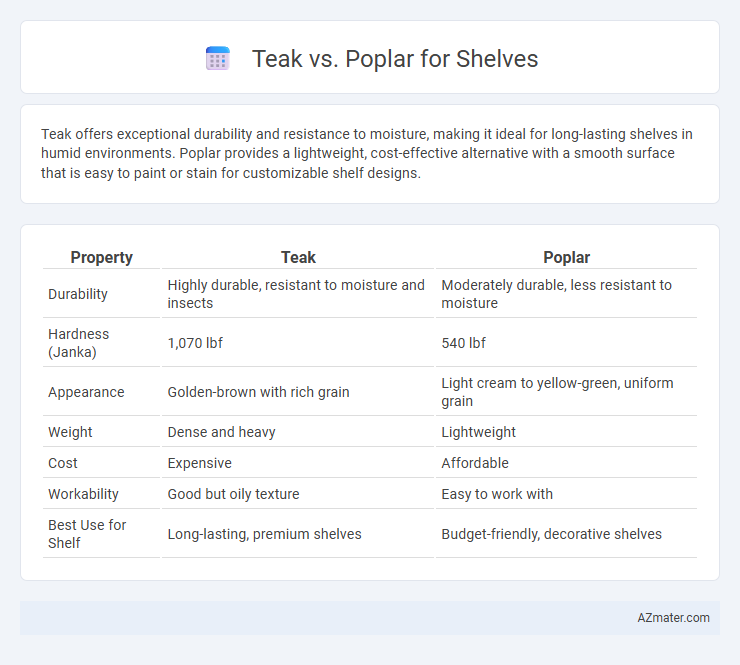Teak offers exceptional durability and resistance to moisture, making it ideal for long-lasting shelves in humid environments. Poplar provides a lightweight, cost-effective alternative with a smooth surface that is easy to paint or stain for customizable shelf designs.
Table of Comparison
| Property | Teak | Poplar |
|---|---|---|
| Durability | Highly durable, resistant to moisture and insects | Moderately durable, less resistant to moisture |
| Hardness (Janka) | 1,070 lbf | 540 lbf |
| Appearance | Golden-brown with rich grain | Light cream to yellow-green, uniform grain |
| Weight | Dense and heavy | Lightweight |
| Cost | Expensive | Affordable |
| Workability | Good but oily texture | Easy to work with |
| Best Use for Shelf | Long-lasting, premium shelves | Budget-friendly, decorative shelves |
Introduction to Teak and Poplar Woods
Teak wood is prized for its exceptional durability, natural resistance to moisture, and rich golden-brown color, making it ideal for long-lasting shelves in humid environments. Poplar, a lightweight hardwood, offers a smooth texture and pale cream to greenish hues, which easily accepts paint and stain for customizable shelf designs. Understanding the distinct grain patterns and hardness levels of teak and poplar helps inform the best choice for functional and aesthetic shelf applications.
Appearance and Color Differences
Teak wood features a rich golden-brown hue with darker streaks, creating a warm, elegant appearance that deepens over time, while poplar is much lighter with a creamy white to pale yellow tone often marked by subtle green or brown streaks. Teak's natural oils give it a smooth, polished finish and a luxurious sheen, contrasting with poplar's matte texture and more uniform color. This pronounced difference in grain and saturation makes teak ideal for premium, decorative shelving, whereas poplar suits minimalist or painted shelf designs.
Strength and Durability Comparison
Teak wood exhibits superior strength and durability compared to poplar, making it ideal for shelves that require long-lasting support and resistance to wear. Its natural oils provide enhanced resistance to moisture, insects, and decay, whereas poplar is softer and more prone to dents and scratches. Poplar shelves may require additional finishing and maintenance to achieve comparable durability, while teak offers a robust, low-maintenance option.
Weight and Workability
Teak wood weighs approximately 41-45 lbs per cubic foot, making it denser and heavier than poplar, which weighs around 26-30 lbs per cubic foot, affecting the shelf's overall load and ease of installation. Poplar excels in workability due to its softer texture and fine grain, allowing for easier cutting, sanding, and staining compared to teak, which is harder and requires specialized tools. The higher density of teak provides superior strength and durability, while poplar offers a lightweight and cost-effective solution for shelving projects.
Resistance to Moisture and Decay
Teak wood exhibits exceptional resistance to moisture and decay due to its natural oils and dense grain structure, making it ideal for shelves exposed to humid or damp environments. Poplar, while affordable and easy to work with, lacks inherent moisture resistance and is more prone to warping, swelling, and fungal decay over time without protective treatments. Consequently, teak's durability and low maintenance requirements make it a superior choice for moisture-prone shelving applications.
Price and Availability
Teak wood is significantly more expensive than poplar due to its durability, natural oils, and high demand in furniture making, often costing three to four times more per board foot. Poplar is widely available and budget-friendly, making it a popular choice for affordable shelving projects, especially in regions where hardwoods are less accessible. While teak's scarcity and import costs limit availability, poplar can be sourced easily from most lumber suppliers across North America and Europe.
Environmental Impact and Sustainability
Teak wood is highly durable and resistant to pests, making it a long-lasting option that reduces the need for frequent replacement, but unsustainable harvesting practices have led to deforestation concerns. Poplar, being a fast-growing hardwood, offers a more environmentally friendly alternative due to its rapid renewability and lower carbon footprint during cultivation. Choosing FSC-certified teak or sustainably managed poplar ensures better environmental outcomes when selecting materials for shelving.
Suitable Shelf Applications for Teak
Teak is highly suitable for outdoor and high-moisture shelf applications due to its natural oil content, which provides exceptional resistance to water, decay, and insects. Its dense grain and durability make it ideal for supporting heavy items and withstanding wear in environments like kitchens, bathrooms, and patios. Teak's rich color and elegant appearance also enhance shelf aesthetics in both functional and decorative settings.
Suitable Shelf Applications for Poplar
Poplar wood is ideal for indoor shelving where moderate durability and smooth finishes are required, making it suitable for decorative shelves, lightweight storage, and painted or stained surfaces. Its affordability and ease of machining allow for custom designs and intricate detailing, perfect for living room or office shelving. Poplar's stability minimizes warping in controlled environments, but it is less suitable for heavy loads or outdoor shelves compared to hardwoods like teak.
Final Verdict: Choosing Between Teak and Poplar for Shelves
Teak offers exceptional durability, natural resistance to moisture and pests, making it ideal for long-lasting shelves in humid environments. Poplar provides a budget-friendly, lightweight option with a smooth surface that is easy to paint or stain but lacks the robustness of hardwoods like teak. For shelves requiring strength and outdoor resilience, teak is the superior choice, while poplar suits indoor, decorative shelving where cost and finish flexibility are priorities.

Infographic: Teak vs Poplar for Shelf
 azmater.com
azmater.com